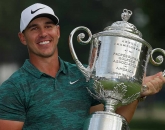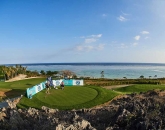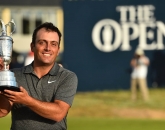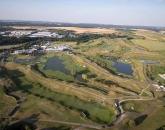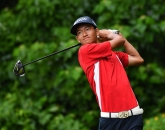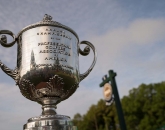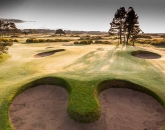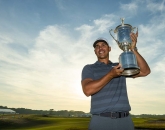A few of the American players, including Corey Pavin, took to wearing camouflage hats during the event. How big a part did the post-Gulf War atmosphere play?
Well I think the fans were going to be quite hyped up anyway. South Carolina is quite a military state. There's a military college in Charleston and there's an air force 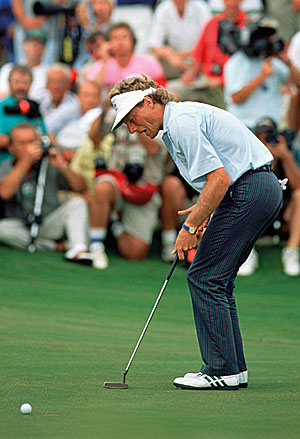 base nearby. It probably gave this thing an extra three to five per cent. Certainly, this was really the first time that the American fans had really gotten into the Cup. But I would say that the organizers weren't shy about the military aspect: there were F-15 flybys to open the Ryder Cup formally. And then the phrase "The War By The Shore" caught fire – it just seemed right.
base nearby. It probably gave this thing an extra three to five per cent. Certainly, this was really the first time that the American fans had really gotten into the Cup. But I would say that the organizers weren't shy about the military aspect: there were F-15 flybys to open the Ryder Cup formally. And then the phrase "The War By The Shore" caught fire – it just seemed right.
But what of Kiawah itself? Despite being a brand new course it was a wild looking place, and it played extremely tough. The par-three 17th was a monster.
I think Pete Dye [the designer] was talked about as much as the players. The Ocean Course is a very difficult design but it turned out well. It was designed for match play. You could go for a three and end up with a six, but that's OK because you only lose one hole. The club of choice on the 17th in 1991 was a 1-iron. I can't remember anyone hitting more than a 5-iron there at the PGA Championship. Technology has changed things a lot. The golf course has softened maybe five per cent because it's fully grassed now. Back in 1991, the left side of 17 was absolute Lawrence of Arabia. I played it a year ago from the back tees. I still love it but I'm a masochist [Laughs].
Looking back, it seems like there was a great cast of characters at the Ryder Cup that year. People like Ballesteros, Olazábal, Faldo for the Europeans and Floyd, Azinger and Pavin for the Americans.
Yes, that's one of the things that appealed to me – the opportunity to write little biographies of the 24 players and the two captains. Where each one was in their careers was interesting. Corey Pavin, for example, had converted from Judaism to Catholicism a few months before. There were some strange little subplots like that, which I like to go into.
I enjoyed talking to Lanny Wadkins. He was very forthcoming. Bernhard Langer, too, was quite forthcoming. He's the guy who became the very identity of this Ryder Cup. Everyone knows the photo of him buckling after missing the putt in the singles. He was blunt about the subject. His memories are not positive. The one really towering figure was Seve Ballesteros, who had so much charisma. They called him the Arnold Palmer of Europe, and I think that's right.
Pages
Click here to see the published article.


